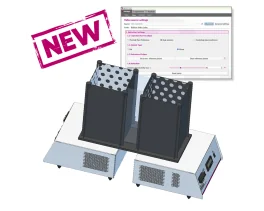Authors
K. Thibault, B. Calvino, S. Pezet.
Lab
CNRS UMR 7637, Ecole Supérieure de Physique et de Chimie Industrielles, Laboratoire de Neurobiologie, Paris, France.
Journal
European journal of Pain
Abstract
Multiple sclerosis is a chronic inflammatory demyelinating disease, associated, in 50-80% of patients, with persistent pain. While the type of pain that affects these patients is being more documented, the mechanisms underlying this pathology are still poorly understood and animal models of such chronic pain associated with MS are required. The aim of our study was to characterize the sensory abnormalities and in particular the clinical signs linked to persistent pain in two models of Experimental Autoimmune Encephalomyelitis (EAE) in the rat. This behavioural characterization tested several sensory modalities such as mechanical and thermal (heat/cold) hyperalgesia or allodynia and explored some of these modalities on two different extremities: the hindpaws and the tail. Our study showed that while one of the model produced more robust motor impairment, animals of both models suffer from mechanical hyperalgesia and thermal allodynia to cold, both at the level of the tail and the hindpaws. While the time-course changes of some of these modalities are shifted in the time between the two models, they represent good models of the sensory abnormalities experienced by MS patients. The second part of our study aimed at characterizing from a pharmacological point of view the most robust model (EAE+Cyclosporine) and showed that Gabapentin, Duloxetine and Tramadol partially relieved some of the clinical signs. Our results suggest that the model EAE+Cyclosporine in the rat is a good model of chronic sensory abnormalities observed in MS patients both from a behavioural and pharmacological point of view.
BIOSEB Instruments Used
Cold Hot Plate Test (BIO-CHP)
Source :

 Pain - Thermal Allodynia / Hyperalgesia
Pain - Thermal Allodynia / Hyperalgesia Pain - Spontaneous Pain - Postural Deficit
Pain - Spontaneous Pain - Postural Deficit Pain - Mechanical Allodynia / Hyperalgesia
Pain - Mechanical Allodynia / Hyperalgesia Learning/Memory - Attention - Addiction
Learning/Memory - Attention - Addiction Physiology & Respiratory Research
Physiology & Respiratory Research











![Dynamic Weight Bearing 2.0 – Postural Module [Add-on]](https://bioseb.com/733-home_default/dynamic-weight-bearing-20-add-on-postural-module.jpg)
























 Pain
Pain Central Nervous System (CNS)
Central Nervous System (CNS) Neurodegeneration
Neurodegeneration Sensory system
Sensory system Motor control
Motor control Mood Disorders
Mood Disorders Other disorders
Other disorders Muscular system
Muscular system Joints
Joints Metabolism
Metabolism Cross-disciplinary subjects
Cross-disciplinary subjects CONFERENCES & MEETINGS
CONFERENCES & MEETINGS 